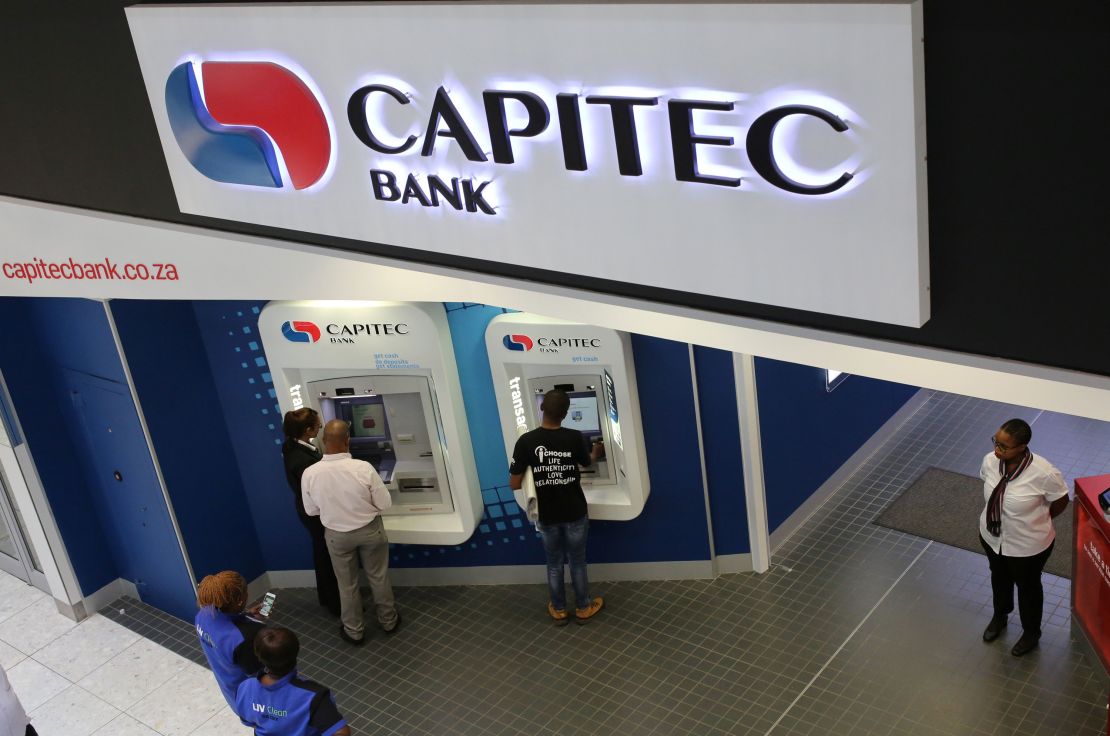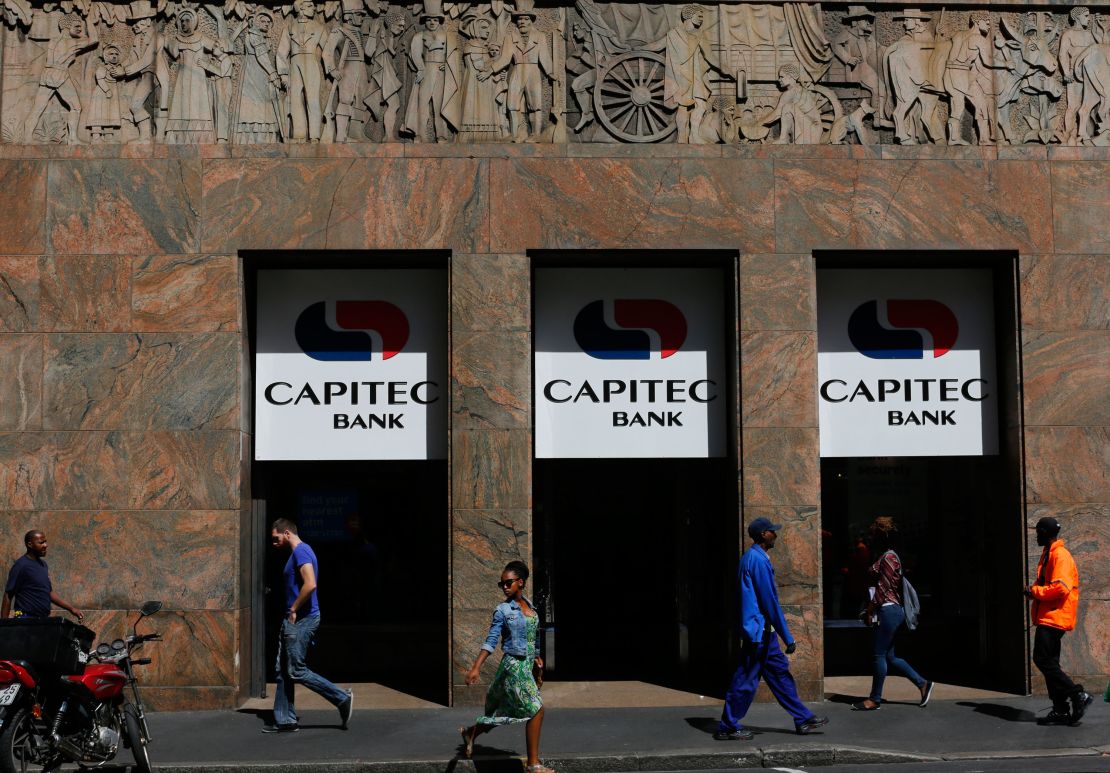How do you get a stock to increase 144,000% in less than two decades? For one South African bank, the answer is a relentless focus on customers others forgot.
Capitec Bank was founded in 2001 by entrepreneurs who loaned money to low-income South Africans ignored by bigger banks. It extended credit to people who didn’t have collateral, such as a home, to secure a loan.
While critics say Capitec (CKHGY) helped fuel a rise in risky loans, its business has thrived. It took less than two decades for the lender to overtake overly confident rivals and amass more customers than any other bank in South Africa.
“It’s an amazing story of how some retailers and farmers managed to break into South Africa’s banking oligopoly, where very few had succeeded historically,” said Stuart Theobald, chairman of the financial services research firm Intellidex.
Simplifying banking
Capitec’s founders cut their teeth selling wine and spirits, working for companies that would later merge to become Distell (DSTZF), Africa’s biggest alcoholic drinks maker.
Believing the four big South African banks made things unnecessarily complicated and expensive for clients, they decided to found a lender with branches that felt more like grocery stores.
“When you’re in liquor [sales] you spend time in townships and shebeens [beer taverns], understanding South Africa in totality. That gave us a better understanding of the client,” Capitec CEO Gerrie Fourie told CNN Business.
Capitec started by removing the fiberglass security screens that typically separated bank tellers from customers, allowing for better service. It also cut loads of red tape to make it easier to apply for a loan.
While rivals would stop serving customers at 3 p.m. to focus on completing paperwork, Capitec deployed technology that improved efficiency and allowed its branches to stay open into the evening.

“What the other banks did wrong is they didn’t see [Capitec] as a real intrusion on their space,” said Kokkie Kooyman, a portfolio manager at South African asset manager Denker Capital.
Capitec might have started out making small loans to people who didn’t have access to other money, but its plan was always to take on market leaders such as FirstRand and Standard Bank (SGBLY), said Kooyman.
When the company debuted its bank account product, it took a novel approach. Instead of creating premium accounts for some customers, it gave everyone the same account with the same gold card — a gamble in a country where bank cards are status symbols.
Capitec still offers just one account, even as wealthier people flock to the lender to save money on bank charges.
The bank said in September that it now has 12.6 million customers — about 30% of the population older than 15 — and that it’s been adding 200,000 new clients per month. Some 5.6 million of its customers have checking accounts, as opposed to savings or credit products.

An obsession with customer service means that new branch workers spend 10 days training at headquarters, which culminates in a graduation ceremony and gala dinner. Fourie personally welcomes each employee to the bank. The relaxed culture is also evident in the design of Capitec’s headquarters, which eschews the statement conference rooms or art collections common at rival banks.
A ruthless focus on keeping costs low has paid off. Capitec has delivered much faster profit growth than its competitors, with earnings increasing by double-digit percentages for each of the past 15 years.
A conservative approach to provisioning for bad debts helped Capitec weather a crisis among small banks around the time of its launch, as well as the 2014 collapse of its largest rival, African Bank. (That bank has since relaunched under new ownership.) Capitec remains obsessed with risk, analyzing its credit performances “in the smallest detail” and tweaking its credit policies monthly, said Fourie.
Investors win big
For Capitec’s shareholders, the payoff has been huge.
When the bank went public in February 2002, its shares were worth little more than 1 rand (7 US cents). The stock is now trading at 1,440 rand ($98), an increase of more than 144,000%. The Johannesburg Stock Exchange All Share Index is up 424% over the same period.
Capitec is “the perfect business school case study on how to grow a bank,” said Theobald, referring to its shift from an operation dependent on shareholder funds and the money it makes off loans to one that now derives 80% of funding from customer deposits and nearly half its income from transaction fees.
The profile of its loans has also changed to cater to its increasingly middle class customer base: the bank now grants unsecured loans of up to 250,000 rand ($16,900) with payback periods of up to seven years.
South Africa’s debt problem
Few would dispute that Capitec has made financial services more accessible. But critics argue the bank bears some responsibility for an explosion in risky lending that has left some customers drowning in debt.
Capitec built its business on unsecured lending — or loans that do not use property or other assets as collateral and typically come with higher interest rates.

Forty percent of the 7.8 million South Africans with an unsecured loan are in default, according to asset manager Differential Capital. Those in default spend a third of their income on average to service the loans.
While Capitec “pushed the envelope” in terms of offering larger loans, all the big banks “contributed enthusiastically” to South Africa’s unsecured lending boom, said Gabriel Davel, CEO of the Centre for Credit Market Development and the previous head of South Africa’s National Credit Regulator.
Capitec is now South Africa’s second biggest unsecured lender after Standard Bank (SGBLY).
Capitec’s new competitors
As it moves away from unsecured lending towards traditional banking, Capitec hopes to steal an increasing share of the market from wary rivals in new areas such as small business lending.
But it is no longer the new kid on the block and will also have to fend off competition from several tech banking startups, which, thanks to Capitec, now know what is possible.
















